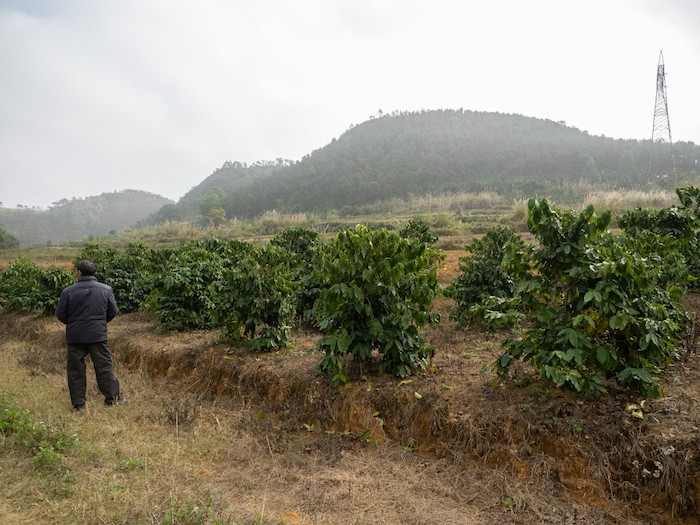After a 20-minute ride along dusty mountain roads on an ancient red motorbike, we arrive at Mingqiang, a small settlement to the west of Zhen’an town, just outside of Yunfu city and near Guangdong’s border with Guangxi.
Upon stepping off the two-wheeled relic, our friendly driver begins introducing us to Mingqiang’s local coffee farmers. One of whom, a man by the name of Feng You, leads us through broods of timid chickens that congregate at the various corners and alcoves of the mud street that connects village houses with the hilly terrain where coffee plants grow.
Feng, formerly in the silkworm trade, was hired by a local company to take care of coffee plants that grow in clumps along the hilltops in this breathtakingly beautiful mountainous area. He gives us a brief tour of the crops and tells us how the coffee industry has provided a more stable source of income than his previous work. He doesn’t have to worry about pests and he gets a small pay-hike in his new line of work. Feng tells us he earns somewhere between RMB40,000 and RMB50,000 a year, which equates to somewhere between RMB3,300 and RMB4,200 per month.

Feng You. Image by Bryan Grogan/That's
Guangdong is not particularly well known for its coffee-growing chops, and neither is China. But all of that is changing as tea farming families begin to see the benefit in juggling both crops throughout a calendar year, according to South China Morning Post. Almost all of China’s coffee plantations are located in the Pu’er region in southwestern Yunnan province, where the famed pu’er tea is grown. There, thousands of coffee-growing families compete in this emerging industry.

Trying some of the Catimor coffee grown in Mingqiang. Image by Bryan Grogan/That's
Eric Baden is CEO and founder of Coffee Commune, a for-profit social enterprise that contributes no less than 10 percent of its profits to providing education and provisions for Yunnan-based farmers. He tells us that the production of coffee in China is certainly growing, but international interest must be swayed by greater care for the quality of coffee beans and farming methods.
“Professional buyers and roasters have often been exposed to Chinese-grown coffees before and many have experienced issues with quality,” says Baden. “So here we have a lot of work ahead of us in terms of changing the perception that Chinese-grown coffee is cheap and ordinary.”
While social enterprises like Eric’s are contributing to the continued growth in quality of beans harvested on China’s coffee farms, governmental subsidies help fund cooperatives who work the hills around Mingqiang village, providing millions of renminbi in capital, as well as fertilizers, coffee seedlings, greenhouses and manpower, a local government worker told That’s. They purchase coffee beans from individual farmers for RMB5 per one jin, or roughly half a kilogram.

The farm is based in the rugged, hilly region between Guangdong and Guangxi. Image by Tristin Zhang/That's
Zheng Xiaoxing is just one of the enterprising individuals who is taking advantage of China’s growing commitment to coffee. As regional manager of Kadi Mu Coffee Planting Cooperative in Yunfu City, Zheng helps to oversee 3,000 mu of coffee-growing land, which equates to just under 500 acres.
Zheng’s cooperative grows a coffee varietal called Catimor, initially developed in Portugal in 1959. Catimor, or Kadi Mu, was made by scientists seeking a plant that would produce high yields and exhibit a high tolerance to diseases, according to Coffeehunter.com. Catimor coffee is grown throughout Vietnam and Indonesia, and works best at high altitudes.
Recently, Zheng has also been experimenting with the popular Asian palm civet method of producing a particularly lucrative form of coffee that’s sometimes referred to as ‘cat poo coffee.’ This method is popular in Southeast Asian countries like Indonesia where beans can sell for a small fortune. Zheng currently owns three civets, to whom he feeds coffee beans. He collects their fecal matter, which contains partially digested beans, and sells them for RMB300 per half kilogram.

Asian palm civet. Image by Tristin Zhang/That's
Zheng remains thoroughly optimistic about the financial rewards that coffee planting can provide. His co-operative first began investigating the area around Yunfu City in 2007, and began planting in 2010. He tells us that 2018 was a particularly good year.
But while China’s coffee industry appears to be off to a good start, it may be some time before the anticipated boom arrives.
“Coffee farming is very hard work, and the benefits of doing it right take several harvest seasons to materialize. When you first plant a coffee tree, it will take three to five years depending on the variety before it yields its first harvest,” Baden tells us. “This also means that it will take at least twice that time before you know if the terroir (the combination of soil, topography and weather) is suitable for the varietal you have chosen to plant. So when you start a new coffee plantation, thorough analysis of the terroir and research into what varietals thrive in similar terroir in other growing regions is vital.”
With that being said, what comes next for China’s coffee-farming areas, like Mingqiang Village? Only time will tell…
[Cover image by Bryan Grogan/That's]






















0 User Comments